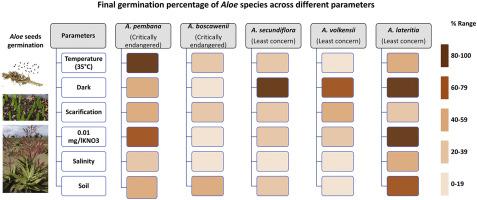Global Ecology and Conservation ( IF 4 ) Pub Date : 2020-08-29 , DOI: 10.1016/j.gecco.2020.e01241 Siri A. Abihudi , Pavithravani B. Venkataramana , Hugo J. de Boer , Anna C. Treydte

|
The majority of Aloe species are threatened by anthropogenic activities, trade, and the effects of climate change, but little is known on seed biology and appropriate conservation measures. Hence, understanding the germination behaviour of Aloe species will help in mitigating the negative effect of changing environmental conditions. “Critically Endangered” (A. boscawenii and A. pembana) and “Least Concern” (A. lateritia, A. volkensii and A. secundiflora) Aloe species’ seed germination was tested under various environmental parameters which are said to be crucial for Aloe species seed germination and included treatments of possible climate change scenarios. We varied temperature, light, scarification, KNO3 addition and salinity and compared the response of the “Critically Endangered” versus the “Least Concern” Aloe species. “Least Concern” Aloe species were used as a control because they have adapted to a wide range of environmental conditions in contrast to “Critically Endangered” Aloe species, which often have a restricted range and specific environmental needs. All Aloe species germinated best at moderate temperatures (25 °C–30 °C) and low KNO3 levels (0.01 mg/l). Dark conditions triggered higher germination percentages for all Aloe species except for A. boscawenii. Saline water suppressed the germination of all Aloe species compared to Aloe species grown in distilled water medium only. Aloe seeds grown in filter paper distilled water medium germinated better than Aloe seeds grown on a soil medium. The “Least concern” (IUCN Red List) A. lateritia germinated better than other species, followed by “Critically endangered” A. pembana and A. secundiflora. Generally, Aloe seed germination is nurtured by moderate temperatures and low concentrations of KNO3. Hence, the effect of global warming will affect the survival of most Aloe species. The better germination performance under shade highlights the importance of parent plants, or at least a healthy canopy cover, in the Aloe species habitat. Aloe seeds showed species-specific responses to various environmental conditions (except for A. pembana), which reflects their Red List status.
中文翻译:

坦桑尼亚的“极度濒危”和“最低关注”芦荟种子萌发对环境条件的物种特异性反应
大多数芦荟物种受到人为活动,贸易和气候变化影响的威胁,但对种子生物学和适当的保护措施知之甚少。因此,了解芦荟物种的发芽行为将有助于减轻环境条件变化带来的负面影响。对“极度濒危”(A. boscawenii和A. pembana)和“最不关注”(A. Lateritia,A。volkensii和A. secundiflora)芦荟物种的种子发芽在各种环境参数下进行了测试,据说这对芦荟至关重要种种子发芽,并包括对可能的气候变化情景的处理。我们改变了温度,光照,划痕,KNO 3的添加和盐度,并比较了“极度濒危”和“最不关注”芦荟物种的反应。之所以使用“最不关注”的芦荟作为对照,是因为它们适应了广泛的环境条件,而“极度濒危”的芦荟通常具有有限的范围和特定的环境需求。所有芦荟物种在中等温度(25°C–30°C)和低KNO 3水平(0.01 mg / l)时发芽最好。黑暗条件引发了所有芦荟的较高发芽率博斯卡文氏菌除外。食盐水抑制所有的发芽芦荟物种相比芦荟在仅蒸馏水的培养基中生长的物种。芦荟在滤纸蒸馏水的培养基中生长的种子发芽比更好芦荟生长的土壤介质上的种子。“最不关心”(IUCN红色名录)的红曲菌比其他物种发芽得更好,其次是“极度濒危”的A. pembana和A. secundiflora。通常,中等温度和低浓度的KNO 3可促进芦荟种子的发芽。。因此,全球变暖的影响将影响大多数芦荟物种的生存。阴影下更好的发芽性能凸显了芦荟物种栖息地中亲本植物或至少健康树冠的重要性。芦荟种子对各种环境条件(除A. pembana以外)均表现出特定物种的反应,这反映了其红色名录的状态。



























 京公网安备 11010802027423号
京公网安备 11010802027423号